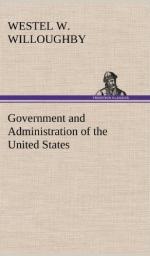Party Machinery.
In all the States, counties, cities, and even in the smaller subdivisions of wards, political parties are thoroughly organized, with acknowledged leaders, and under systems of rules or party government. This party government, or “machine,” as it is called, has been created by no law or constitution, but is one which has been gradually formed by the voters themselves, and under which they have voluntarily placed themselves, in order better to succeed in their elections, well realizing that the best chance of success is by having all the voters of their party united on certain principles embodied in a party platform, and having candidates so nominated that the whole party will recognize them as their choice.
The aims of party organization are: First, union, that is, having all voters united as to candidates and platform; and second, recruiting or the gaining of new adherents.
There are at present two opposing political parties, both striving for the control of the Government. Both have very nearly the same system of party government, but their organizations are totally distinct and separate one from the other.
There are two distinct parts of party government. They are; first, sets of committees, whose business it is to do all the work of managing elections, such as raising and applying funds for election purposes, organizing meetings, providing speakers, publishing and distributing political tracts and other information, and stirring up enthusiasm by parades and fireworks, etc. They have also the important duty of calling together nominating conventions.
The second part of the “machine” embraces the nominating conventions, which propose the names of the candidates whom their party are to support for election. These assemblies are called together by the committees periodically, for the purpose of specific nominations, and cease to exist as soon as their work is done. Besides nominating candidates, the conventions draw up the platform, which is a statement of party principles, beliefs, and pledges. To provide for their reassembling next time, they also elect a new committee, for the next term; and also send delegates to the next higher convention. Thus are found committees and a nominating convention, managing not only national and state elections, but even arranging and managing elections in the smaller electoral subdivisions.
There is a committee and a nominating convention for every city, for every county, for every district, and for every State. There are, then, throughout the whole United States, such committees, each controlling its own local affairs, but yet all related to each other, thus forming one vast organized system.




